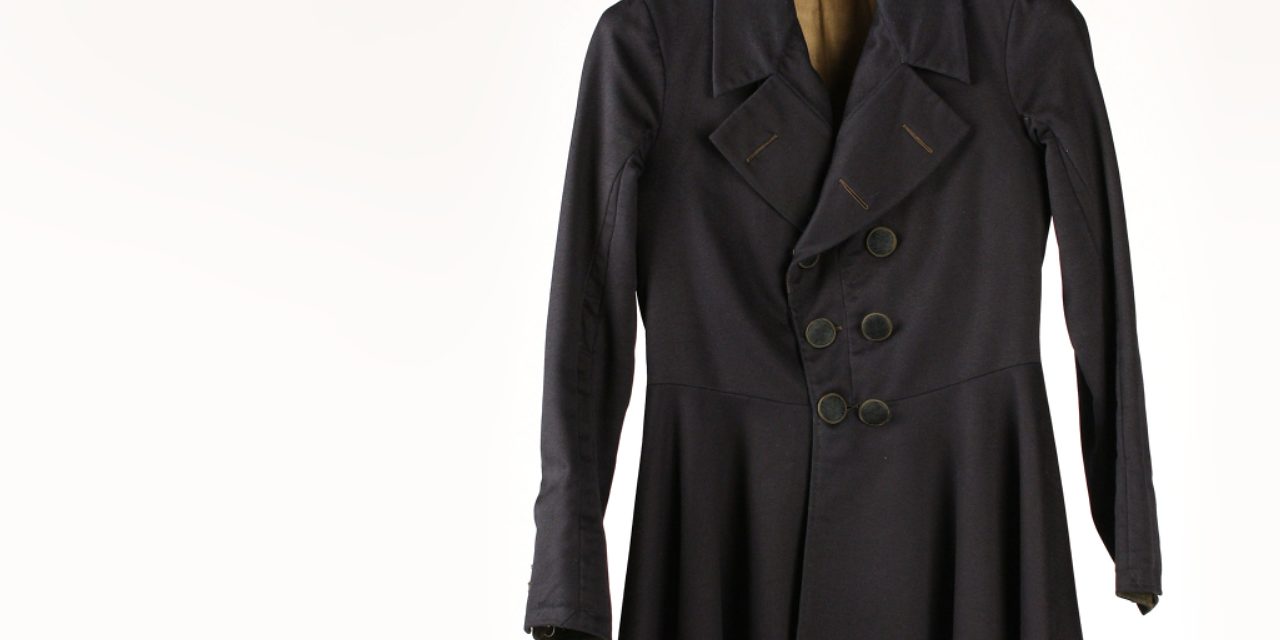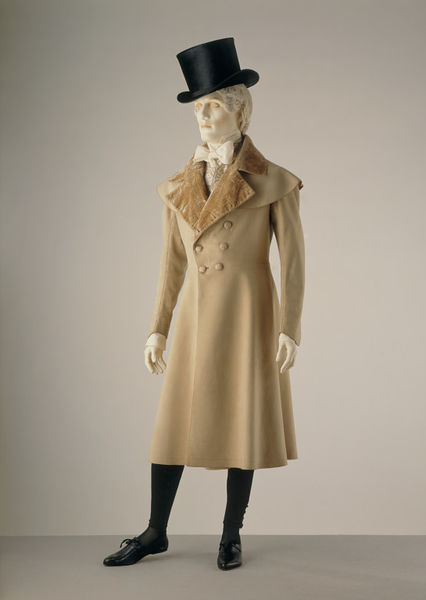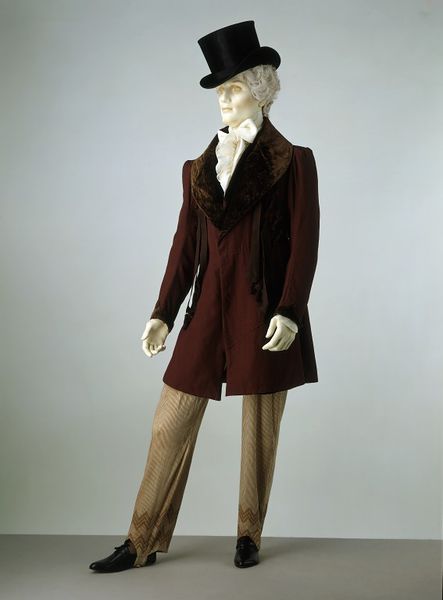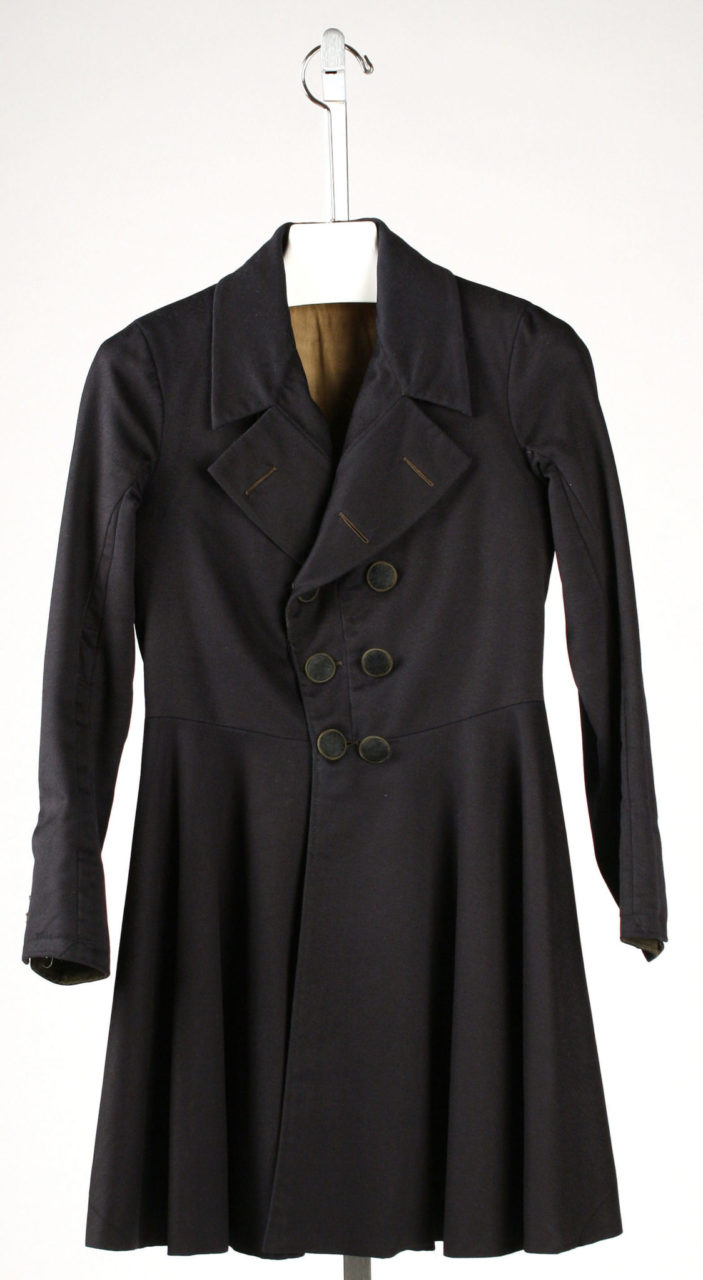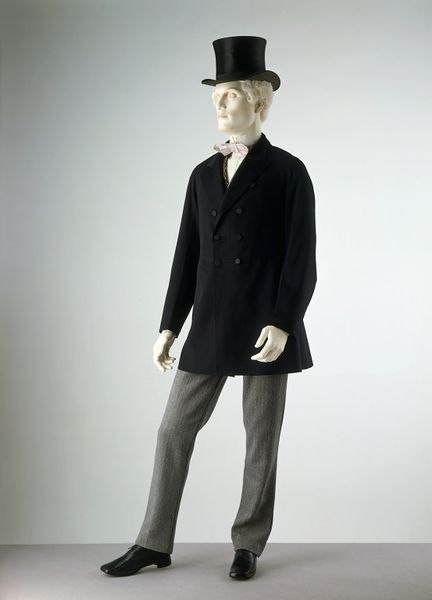The frock coat is a collared man’s coat worn through the eighteenth to the twentieth century. It rose to prominence mainly in the nineteenth century, especially Victorian England. It is characterized as a knee-length overcoat, buttoned down to the waist, that drapes over the lower half of the body like a skirt.
The Details
Fashion: The Definitive History of Costume and Fashion (2012) offers a concise definition of a frock coat, defining it as: “A man’s coat reaching to the knee, buttoned down to waist level, and with full skirts.” (444)
Anderson Black and Madge Garland also define the frock coat simply in A History of Fashion (1980), as: “A knee-length overcoat, popular in Victorian England.” (290)
In The Fairchild Dictionary of Fashion (2003), Charlotte Mankey Calasibetta and Phyllis Tortora discuss in more detail the defining characteristics of the frock coat, in reference to the time period the coat was prominent in, writing:
“Suit coat of the 18th c. that was looser and shorter than dress coats. Single or double breasted, it buttoned to the waistline. At first it had a full skirt, flapped pockets, and a vent in back with two buttons at waist-line, and a flat, turned down collar and no lapels. Initially considered suitable for country wear, but after 1770 was accepted for more formal wear as well. Less popular during the Empire period, the frock coat was important from 1816 until the end of the 19th c., after which it was worn by dignitaries and older men. The specific cut varied depending on the current fashionable silhouette, but the 19th c. coat always had a fitted waist attached with a waistline seam to a knee-length skirt that fell straight and met at the center front.” (94)
The Victoria and Albert Museum in London has a variety of nineteenth-century frock coats in their collection. Of Figures 1 and 2, the V&A writes:
“By the early 19th century, the coat was completely cut away in front, offering little protection or warmth. A new style of coat – the frock-coat – was introduced between 1815 and 1820. It had skirts to the knees and buttoned in front. It was influenced by the style of the greatcoat (overcoat), but was more fitted in shape. Worn first as informal daywear, the frock-coat soon became the formal day-coat of the 19th century. This example in beige wool has ‘capes’ over the shoulder and a collar of velvet. The weight of the skirts of the new frock-coat made it difficult to cut the fronts in one piece, so a waist seam was introduced in the 1820s.”
Fig. 1 - Designer unknown (British). Frock coat, 1820-1830. Wool, trimmed with silk velvet, lined with silk, hand-sewn. London: Victoria and Albert Museum, T.294-1910. Given by Mr Talbot Hughes. Source: V&A
Fig. 2 - Designer unknown (British). Frock coat, 1828-1830. Silk and worsted, faced with silk velvet, lined with silk, metal, hand-sewn. London: Victoria and Albert Museum, T.136-1967. Source: V&A
Fig. 3 - Designer unknown (American). Frock coat, 1840s. Wool. New York: The Metropolitan Museum of Art, C.I.60.22.6. Gift of International Business Machines Corporation, 1960. Source: The Met
Fig. 4 - Designer unknown (Irish). Double-breasted frock coat, 1871. Fine wool. London: Victoria and Albert Museum, T.47-1947. Given by Mr A. W. Furlong. Source: V&A
Fig. 5 - Designer unknown (British). Frock coat, 1890. Wool with silk revers, lined with sateen and cotton shirting, hand-sewn and machine-sewn. London: Victoria and Albert Museum, T.624-1996. Given by Mrs Valerie Mendes. Source: V&A
Karen Baclawski discusses the origins of the frock coat and the aesthetic developments it went through as it rose to prominence in The Guide To Historic Costume (1995), writing:
“A man’s collared coat worn from the eighteenth century to the twentieth century. The eighteenth century frock coat, often referred to by contemporaries simply as the ‘frock,’ was identifiable in fashionable circle from the 1720s. It was a single-breasted coat, adapted from the working man’s garment, made of woolen cloth with a small turned-down collar and small cuffs or slit sleeve ends. Dress coats of the period were full-skirted and collarless; the collar on the frock and its slim silhouette with less emphasis on the side pleats indicated its informal nature. Frock coats were much worn in the country and for sporting pursuits, generally with light-colored cloth or buckskin breeches and the boots. By the 1750s, the frock was widely accepted for everyday dress. The frock had grown smarter in appearance and its cut altered with the fashion, but it remained a comfortable garment to wear. By this time, frock coats were also made from materials other than wool, including linen and cotton for summer use.
By the 1770s, there was a French version of the frock, which was smarter still, for it fitted better and could be embroidered, and thus became permissible for most formal occasions as part of a suit. In the 1780s, large buttons and tight sleeves with round cuffs featured prominently on plain-coloured frocks, which were usually worn with contrasting waistcoat and breeches; the skirts were now very reduced, appearing more as tails. At the very end of the century and during the early years of the nineteenth century, the frock lost ground to the cutaway tail coat.
The frock was revived as the frock coat about 1815. Very different from the frocks of the previous century, nineteenth-century frock coats were characterized by full skirts overlapping at the centre front. A frock coat had a turned-down collar and could be single – or double – breasted. By the 1830s, the skirts of the frock coat were very full indeed, creating a silhouette which echoed women’s fashions. The frock coat was the standard coat for formal wear in the second half of the century. Dark colors, usually navy or black, were preferred.” (113)
Valerie Cumming defines a frock coat in The Dictionary of Fashion History (2010) as:
“A sporting and informal coat which appeared in fashionable circles in the 1720s. That version had a small, turned-down collar and sleeves with narrow cuffs or slits. By the last quarter of the 18th century it had become acceptable formal wear. [As of 1816] It became a formal, waisted and close-fitting coat, at first single-breasted with roll or Prussian collar and no lapels; buttoned to the waist-level. It had a full skirt hanging vertically in front, the back with a vent, side pleats and hip-buttons. [As of 1823] It acquired a seam at the waist, collar and lapels, and pockets on the hips under flaps. With minor variations this remained the basic style for the rest of the century; it was often called a morning frock coat in the 1870s and 1880s to distinguish it from the dress frock coat.”
Fig. 6 - Alexander McQueen. Menswear, Fall 2017. Photo: Courtesy of Alexander McQueen. Source: Vogue
Its Afterlife
Frock coats continue to be a fashion item in modern menswear as seen in Alexander McQueen’s Fall 2017 Menswear Collection (Fig. 6).
References:
- Baclawski, Karen. The Guide to Historic Costume. New York: Drama Book Publishers, 1995. http://www.worldcat.org/oclc/60155138.
- Black, J. Anderson, Madge Garland, and Frances Kennett. A History of Fashion. New York: Morrow, 1980. http://www.worldcat.org/oclc/929912599.
- Brown, Susan, ed. Fashion: The Definitive History of Costume and Style. New York: DK Publishing, 2012. http://www.worldcat.org/oclc/840417029.
- Cumming, Valerie, C. Willett Cunnington, and Phillis Cunnington. The Dictionary of Fashion History. Second edition. New York: Bloomsbury Academic, 2017. http://www.worldcat.org/oclc/1005133322.
- “Frock Coat.” Wikipedia. Accessed February 18, 2018. https://en.wikipedia.org/w/index.php?title=Frock_coat&oldid=806654987.
- Tortora, Phyllis G., Sandra J. Keiser, and Bina Abling. The Fairchild Books Dictionary of Fashion. 4th edition. New York: Fairchild Books, 2014. http://www.worldcat.org/oclc/900349357.

